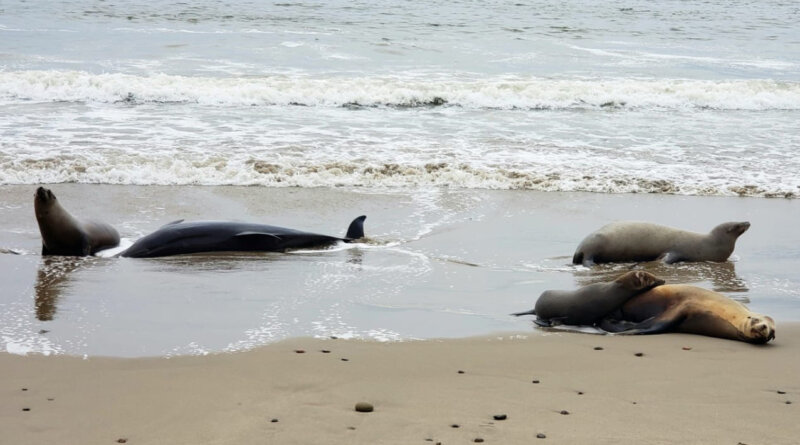What to know about the sick and dying sea lions washing ashore in California : NPR

Pregnant sea lions have been the most likely to die from toxic poisoning from algal blooms along Southern California’s coast.
Channel Islands Marine & Wildlife Institute
hide caption
toggle caption
Channel Islands Marine & Wildlife Institute

Pregnant sea lions have been the most likely to die from toxic poisoning from algal blooms along Southern California’s coast.
Channel Islands Marine & Wildlife Institute
It looked like something out of an apocalyptic movie.
Over the past few weeks, droves of sick and dying sea animals have been washing up along the coast of Southern California, including beaches in Santa Barbara and Ventura.
The devastation has been caused by an outbreak of toxic algae on a scale never before seen in the region, according to NOAA Fisheries’ West Coast branch.
As of last week, local officials had estimated that over 100 dolphins and over 500 sea lions had been killed by the algal bloom. It appears that the toxins are slowly spreading to Northern California.

Channel Islands Marine & Wildlife Institute has been able to rescue over 100 sea mammals that were suffering from the algae outbreak.
Channel Islands Marine & Wildlife Institute
hide caption
toggle caption
Channel Islands Marine & Wildlife Institute
Samuel Dover, who leads Channel Islands Marine & Wildlife Institute, has witnessed six algal blooms during his career and described the current one as the worst yet.
“The bloom is so much larger,” he told NPR. “This time, it’s in the center of the channel, where a lot of animals are.”
What is an algal bloom?
Algae are usually benign plants, commonly seen in the form of pond scum or kelp. But under certain conditions, they can grow out of control and generate deadly toxins.
When that happens, it is known as a bloom. It tends to be a problem for U.S. states near the country’s coast and the Great Lakes. Over the years, algal blooms have contaminated tap water, forced beaches to close, discolored coastal waters and led to the demise of countless animals.
Although algal blooms are considered a natural phenomenon, climate change and human activities do play a role in their frequency and intensity.
In California, the algae outbreak is believed to have resulted from wind pushing water full of nutrients toward algae, making them grow. That process is not typically related to climate change, but it does not rule it out as a factor either, according to scientists at NOAA Fisheries’ West Coast branch.
What are algae doing to the sea lions in California?
The bloom in California is producing domoic acid, which generally doesn’t affect humans but is poisonous to animals.
When a sea creature suffers from domoic acid poisoning, it affects the animal’s brain and causes seizures, erratic behavior, bulging eyes and foaming at the mouth. Beachgoers have been warned to stay at least 50 feet away from sick animals in case they turn aggressive.

Beachgoers have been asked to stay at least 50 feet away from animals poisoned by toxic algae because of the risk that the sea creatures may turn aggressive.
Channel Islands Marine & Wildlife Institute
hide caption
toggle caption
Channel Islands Marine & Wildlife Institute

Beachgoers have been asked to stay at least 50 feet away from animals poisoned by toxic algae because of the risk that the sea creatures may turn aggressive.
Channel Islands Marine & Wildlife Institute
There is no antidote or specific remedy for domoic acid poisoning. Veterinarians have been giving some animals antiseizure medicine and keeping them hydrated in hopes that the toxins will flush out of their bodies. The problem is that the longer the toxins are in an animal’s system, the more difficult it becomes to treat the poisoning.
Adult pregnant sea lions have been the most severely affected by the outbreak, according to Dover, of Channel Islands Marine & Wildlife Institute.
When will it get better?
When Southern California was struck by an algal bloom last year, it lasted about six weeks, Dover said.
Similarly, the current outbreak, in its eighth week, appears to be improving, and fewer sick animals are appearing on shores.

There is no antidote or specific remedy for poisoning from domoic acid, the toxin that the algal bloom in California is producing.
Channel Islands Marine & Wildlife Institute
hide caption
toggle caption
Channel Islands Marine & Wildlife Institute

There is no antidote or specific remedy for poisoning from domoic acid, the toxin that the algal bloom in California is producing.
Channel Islands Marine & Wildlife Institute
To compare, Dover said lately his volunteer group has been receiving about 40 to 50 reports of sick animals per day. A month ago, they were receiving 40 to 50 reports per hour, though many reports tend to be duplicates of the same animal.
While that is a good sign, not much can be done to speed up the process. Harmful algal blooms are nearly impossible to clean, especially at the scale that has emerged near California.






